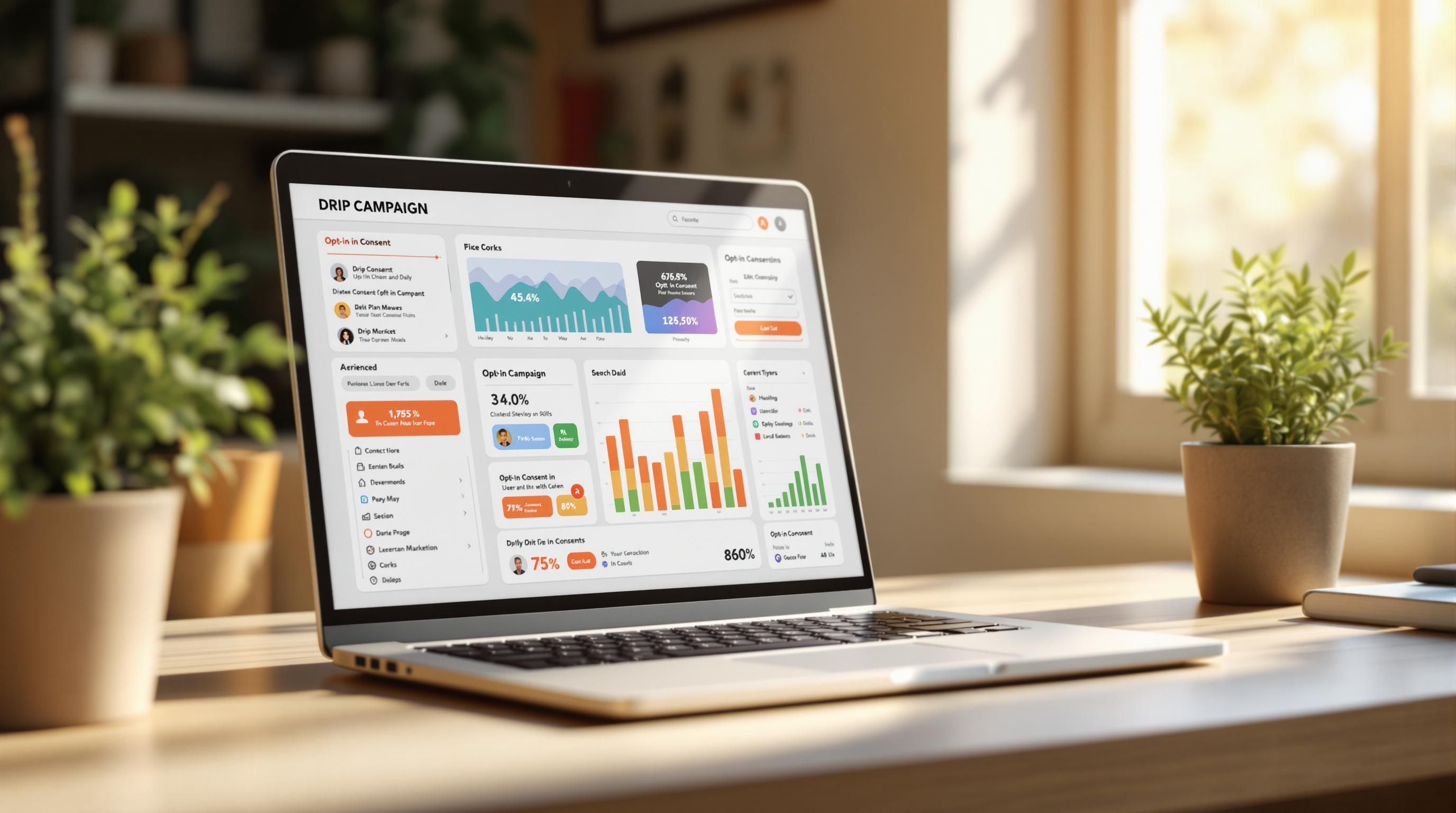Video engagement metrics help you understand how your audience interacts with your content. They show what works, what doesn’t, and where to improve. Here’s a quick overview of the most important metrics to track:
- View Count: Measures how far your video reaches.
- Watch Duration: Shows how engaging your content is.
- Likes, Comments, Shares: Indicates audience interest and connection.
- Retention Stats: Pinpoints where viewers drop off or rewatch.
- Conversions: Tracks actions like clicks, sign-ups, or purchases.
To get started, choose the right analytics tool (e.g., YouTube Studio, Vimeo Analytics) and set up a dashboard to monitor key metrics. Use insights to adjust your content strategy, test new ideas, and improve viewer retention. Tracking these metrics ensures your videos perform better and align with your goals.
Using YouTube Analytics to Improve Your Video Strategy
Main Metrics to Monitor
Tracking the right video metrics helps shape a smarter content strategy based on data.
View Count and Watch Duration
View count shows how far your video has reached, while watch duration reflects how engaging your content is.
| Metric | What It Tracks | Why It Matters |
|---|---|---|
| Total Views | Number of video plays | Measures overall reach |
| Average Watch Time | How long viewers watch | Indicates engagement depth |
| Complete Views | Full video watches | Highlights value provided |
| Peak Viewing Times | High-traffic times | Helps optimize posting schedule |
Keep in mind that different platforms may favor varying video lengths. Tailor your content accordingly.
Next, let’s dive into how viewers are interacting with your videos.
Audience Actions: Likes, Comments, Shares
Engagement metrics provide insight into how your content resonates with viewers. These actions reflect how much value your audience finds in your videos.
Here’s what to monitor:
- Like-to-View Ratio: A quick way to gauge how much viewers appreciate your content.
- Comment Sentiment: Offers feedback and potential areas for improvement.
- Share Rate: Indicates how well your content spreads among viewers.
- Click-Through Rate (CTR): Measures how effective your call-to-action is.
Viewer Retention Stats
Retention metrics help you understand where viewers stay engaged and where they drop off, offering clues for improving your content.
Key retention stats include:
- Average View Duration: The typical length of time viewers stay tuned.
- Drop-off Points: Pinpoints where viewers lose interest.
- Rewatch Rate: Highlights parts of the video that grabbed extra attention.
- Audience Retention Graph: A visual breakdown of engagement over time.
It’s worth noting that most drop-offs occur in the first 15 seconds of a video. Starting strong and delivering immediate value can keep viewers watching longer.
Video Analytics Setup Guide
Tracking video engagement metrics is essential for understanding your audience and improving performance. Here's how to set up an efficient video analytics system.
Choosing the Right Analytics Tool
Pick an analytics tool that aligns with your hosting platform. Many platforms already include built-in analytics. Here's a quick comparison:
| Platform | Key Features | Best For |
|---|---|---|
| YouTube Studio | Audience insights, real-time data | Content creators, marketers |
| Vimeo Analytics | Player heatmaps, viewer geography | Business videos, professionals |
| TikTok Analytics | Follower activity, sound trends | Short-form content |
| LinkedIn Video | Professional audience data, B2B metrics | Business communication |
Look for tools that allow data exports, API access, and seamless integration with other platforms.
Setting Up Your Dashboard
Once you've picked your tool, create a dashboard to monitor your most important metrics.
1. Define Your KPIs
Decide which metrics matter most, such as engagement rate, viewer retention, or conversion rate.
2. Customize Data Views
Organize data for different time periods to spot trends and patterns:
- Daily for immediate feedback
- Weekly for short-term trends
- Monthly for performance comparisons
- Quarterly for long-term strategy
3. Automate Reporting
Set up automated reports to keep track of metrics without manual effort. This ensures you consistently monitor performance.
Integrating with Marketing Tools
Link your video analytics to other marketing software for a complete performance overview. Most platforms support direct integration with:
- CRM Systems: Sync viewer data with customer profiles.
- Email Marketing Tools: Measure video engagement in campaigns.
- Social Media Platforms: Track performance across channels.
- Analytics Tools: Combine video stats with website data.
Use tracking codes and UTM parameters to accurately measure engagement and conversion sources. This helps tie your video efforts to tangible results.
sbb-itb-a84ebc4
Making Sense of Video Data
Finding Data Patterns
Look at how viewers interact with your videos to uncover trends. Pay attention to the types of content they prefer, the times they engage most, and where they tend to stop watching. Engagement heat maps can highlight parts of the video that keep viewers hooked. Testing early calls-to-action (CTAs) can also show whether they help retain viewers. These insights help you set benchmarks for what works.
Measuring Success Rates
Evaluate metrics like view duration, engagement rate, click-through rate (CTR), and share rate. Compare these numbers to industry standards to see how your content stacks up. Keep in mind that different platforms have unique audience behaviors - what works on a professional network may not perform the same on a casual platform. These comparisons guide your content improvement efforts.
Content Updates Based on Data
Use the data to fine-tune your videos:
- Cut out parts where viewers often drop off and make sure the beginning grabs attention right away.
- Add chapter markers to help viewers navigate longer videos.
- Place your key messages during moments of peak interest, and include clear CTAs when engagement is highest.
- Experiment with different thumbnail designs to attract more viewers.
Align your posting schedule with your audience's most active times. Tailor video length to fit the platform and stick to topics that consistently resonate. By tracking these changes, you’ll discover what works best for your audience and find new ways to improve.
Pro-Level Analysis Methods
Audience Data Groups
Break down your analytics into detailed viewer profiles to better understand your audience. Group viewers by factors like geographic location, device type, and preferred viewing times. Look at watch patterns to spot trends, such as identifying loyal viewers versus those who drop off early.
Pay attention to how vertical and horizontal videos perform among mobile users. Also, consider age-group preferences - short, fast-paced videos often appeal to younger audiences, while longer, more in-depth content tends to resonate with professionals.
Use these observations to adjust and test specific video elements for better engagement.
Video Testing Methods
A/B testing is a great way to fine-tune your video content. Test one element at a time to see what works best:
- Try different thumbnail designs.
- Compare engagement levels for short videos (1–3 minutes) versus longer ones (8+ minutes).
- Experiment with various opening sequences.
- Adjust CTA (call-to-action) timing to occur at 25%, 50%, or 75% of the video.
Run each test for at least two weeks to gather enough data. Record the results and apply the winning strategies to future videos. Keep your goals in mind - such as prioritizing view duration for educational videos or click-through rates for promotional content.
These tests provide valuable insights that can sharpen your content strategy and give you a solid foundation for future analysis.
Future Performance Analysis
Use the insights from your audience data and A/B tests to predict future trends with confidence. Dive into historical data to uncover seasonal patterns and audience behaviors. Look for connections between specific video elements and engagement metrics, such as:
- How the time of day affects view counts.
- Which topics drive the most interaction.
- The ideal video length for each content type.
- Differences in performance across platforms.
Build a prediction model by tracking key metrics like:
- Engagement rates within the first 48 hours.
- Viewer retention trends.
- Share velocity (how many shares happen per hour in the first 24 hours).
- The tone and frequency of comments.
Focus on recurring patterns rather than one-time spikes. This approach helps you make more reliable predictions about future video performance and ensures smarter resource allocation for content creation and promotion.
Conclusion
Key Takeaways
Video engagement metrics are essential for shaping your content strategy. They help you understand viewer behavior, retention, and interaction trends. By combining audience segmentation with A/B testing, you can build a strong foundation for improving your videos. Regularly analyzing data allows you to make better decisions about content length, timing, and format - turning insights into practical steps for ongoing improvement.
Next Steps
To boost your video performance, consider these practical actions:
- Integrate analytics tools into your marketing stack to track performance effectively.
- Schedule regular tests to experiment with different content strategies.
- Segment your audience based on their viewing habits and engagement levels.
- Monitor KPIs weekly to identify patterns and adjust your approach as needed.
For additional support, resources like the Marketing Funnels Directory offer tools to improve video marketing analytics and automation, making it easier to collect and optimize your data.


